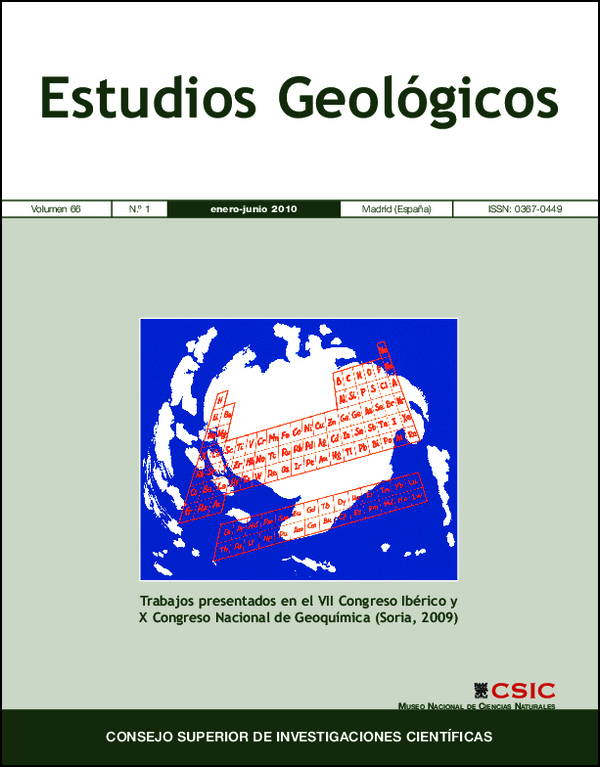Isotopic geochronology of granitic rocks from the Central Iberian Zone: comparison of methodologies
DOI:
https://doi.org/10.3989/egeol.40143.097Keywords:
geochronology, zircon, monazite, U-Pb, U-Pb-Th, Sr-Nd, uranium, lead, thorium, strontium, neodymium, delta-18-oxygen, Castelo Branco pluton, PortugalAbstract
Five granitic rocks, concentrically disposed from core to rim, were distinguished in the Castelo Branco pluton. U-Pb-Th electron microprobe monazite ages from granitic rocks are similar and ranging between 297-303 Ma. The granitic rocks from Castelo Branco pluton are 310 ± 1 Ma old, obtained by U-Pb (ID-TIMS) in separated zircon and monazite crystals, indicating a similar emplacement age for all granitic rocks of the pluton. Initial 87Sr/86Sr isotopic ratios and εNd310 and δ18O values suggest three distinct pulses of granitic magma and that they are derived from partial melting of heterogeneous metasedimentary materials. The other granitic rocks are related by magmatic differentiation and show small variations in (87Sr/86Sr)310, εNd310 and δ18O. The granitic pluton of Castelo Branco shows a rare reverse zoning.
Downloads
References
Antunes, I.M.H.R.; Neiva, A.M.R.; Silva, M.M.V.G. & Corfu, F. (2008). Geochemistry of S-type granitic rocks from the reversely zoned Castelo Branco pluton (central Portugal). Lithos, 103: 445-465. doi:10.1016/j.lithos.2007.10.003
Azevedo, M.R.; Valle Aguado, B.; Nolan, J.; Martins, M. & Medina, J. (2005). Origin and emplacement of synorogenic Variscan granitoids in Iberia the Beiras massif. In: The southern Variscan Belt. (Carosi R.; Dias, R.; Lacopini, D. & Rosenbaum G., eds.), Journal of the Virtual Explorer, Electronic Edition, 19, Paper 7.
Corfu, F. (2004). U-Pb geochronology of the Lekres group: an exotic Early Caledonian metassedimentary assemblage stranded on Lofoten basement, northern Norway. Journal of the Geological Society of London, 161: 619-627. doi:10.1144/0016-764903-066
Dias, G.; Simões, P.P.; Ferreira, N. & Leterrier, J. (2002). Mantle and Crustal Sources in the Genesis of Late- Hercynian Granitoids (NW Portugal): Geochemical and Sr-Nd Isotopic Constraints. Gondwana Research, 5: 287-305. doi:10.1016/S1342-937X(05)70724-3
Ferreira, N.; Iglésias, M.; Noronha, F.; Pereira, E.; Ribeiro, A. & Ribeiro M.L. (1987). Granitóides da zona Centro-Ibérica e seu enquadramento geodinâmico. In: Geologia de los granitoides y rocas asociadas del Macizo Hespérico, Libro Homenaje a L.C.G. Figueirola (Bea, F.; Carmina, A.; Gonzalo, J.C.; Plaza, M.L. & Rodrigues, J.M.L., eds.), Editorial Rueda, Madrid, 37-53.
Krogh, T.E. (1973). A low contamination method for hydrothermal decomposition of zircon and extraction of U and Pb for isotopic age determination. Geochimica et Cosmochimica Acta, 37: 485-494. doi:10.1016/0016-7037(73)90213-5
Martínez Catalán, J.R.M.; Martínez Poyatos, D. & Bea, F. (2004). Zona Centroibérica: Introducción. In: Geología de España (Vera, J.A., ed.). Instituto Geológico y Minero de España (SGE-IGME), Madrid, 68-69.
Montel, J.M.; Foret, S.; Veschambre, M.; Nicollet, C. & Provost, A. (1996). Electron microprobe dating of monazite. Chemical Geology, 131: 37-53. doi:10.1016/0009-2541(96)00024-1
Montero, P. & Bea, F. (1998). Accurate determination of 87Rb/86Sr and 147Sm/144Nd by inductively coupled plasma mass spectrometry in isotope geoscience: an alternative to isotope dilution analysis. Analytica Chimica Acta, 358: 227-233. doi:10.1016/S0003-2670(97)00599-0
Neiva, A.M.R. & Gomes, M.E.P. (2001). Diferentes tipos de granitos e seus processos petrogenéticos: granitos hercínicos portugueses. Memórias da Academia das Ciências de Lisboa, 39: 53-95.
Rollinson, H. (ed.) (1993). Using Geochemical Data: Evalution, Presentation and Interpretation. Longman, UK, 352 pp.
White, J. (2003). High temperature applications II: Oxygen isotopes as an indicator of assimilation. University of Cornell, Earth & Atmospheric Sciences 656, Isotope Geochemistry Lectures, 30: 227-231.
Downloads
Published
How to Cite
Issue
Section
License
Copyright (c) 2010 Consejo Superior de Investigaciones Científicas (CSIC)

This work is licensed under a Creative Commons Attribution 4.0 International License.
© CSIC. Manuscripts published in both the print and online versions of this journal are the property of the Consejo Superior de Investigaciones Científicas, and quoting this source is a requirement for any partial or full reproduction.
All contents of this electronic edition, except where otherwise noted, are distributed under a Creative Commons Attribution 4.0 International (CC BY 4.0) licence. You may read the basic information and the legal text of the licence. The indication of the CC BY 4.0 licence must be expressly stated in this way when necessary.
Self-archiving in repositories, personal webpages or similar, of any version other than the final version of the work produced by the publisher, is not allowed.















